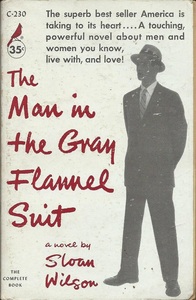
Below is the review I did on Goodreads:
https://www.goodreads.com/review/show/1009625789.
Rafeeq
Whenever I watch The Man in the Gray Flannel Suit with Gregory Peck, I say, "Boy, it'd be nice to read the original novel by Sloan Wilson sometime, wouldn't it?"...and when I at last came across an old 1956 printing in the local library basement sale, this old paperback shouldered its way immediately to the top of my reading list. I was not disappointed. It is an enjoyable and moving five-star work.
The basics of the novel--a combat veteran haunted by memories of the men he killed, and by the brief, desperate love he found in Italy, tries to turn his mousy career and his dispirited marriage around by joining the "rat race"--are familiar to anyone who has seen the film, so there is little need to cover them here. The novel, of course, is more finely grained in its telling detail than any film, and such detail is lifelike and good, and ultimately moving.
On the one hand, Wilson's narrative voice can be urbane and gently wry. After spending most of the first page describing a question-mark-shaped crack in the wall of the couple's dingy house, for example, the text reports with calm irony that this suspicious shape "d[oes] not seem symbolic to Tom and Betty, nor even amusing"--and in case we still don't get it, another nudge points out that everyone else cannot help staring at the thing. Sentences of the offhand "It was fashionable that summer to be cynical about one's employers..." variety are a similar joy.
Coupled with such minor authorial games, however, is a rich investigation of the mind of ex-paratrooper and now vaguely wary husband Tom Rath. During the Second World War, in close combat, Rath killed seventeen men--a fact "he simply hadn't thought about for quite a few years" rather than "a thing he had deliberately tried to forget." Mm hmm. And yet, as he thinks of those years, "His mind [goes] blank. Suddenly the word 'Maria' flashe[s] into it"...and yet, at least this early on, all we will get is that single word, and then the narrative tacks intriguingly away.
Wilson will give more in due time, of course. He will show us Rath's bleak fatalism of December '44, when after two years of fighting in Europe his unit is to be sent to the Pacific, and he knows--knows--that his luck will run out, and in another jump, or two at the most, he will be dead. The future he will never see, the cold beer he will never drink, the rare steaks he will never eat, the lovely wife waiting at home, to whom he will never make love again--they do not seem real, while only the vulnerable and passionate Maria makes life at all palatable. And of course, just before shipping out to the Pacific Theater, he learns that there may be a child...
The friend killed by Rath's grenade, the unacknowledged longing for Maria and his abandoned child, his own absent father shell-shocked in the First World War and then likely suicided in the '20s, the ancient grandmother with her tales of family glory, the faithful wife who wants to see him happy and successful--the introspective Tom Rath is pushed and pulled by impetuses he struggles to understand. And if he is to start living again, truly living, he will have to face the truth, as he has been avoiding for so long.
Is the ending a little too pat? Perhaps. Certainly Betty Rath, after a revelation that could indeed finish many a marriage, ends up being an astoundingly good sport about it. Would Tom be as forgiving, one might wonder, if Betty, as convinced as he had been of his imminent death, had found comfort as he did in Rome? Maybe at this stage of the novel he might. Wilson does not quite raise the question, however--unfortunate, as even a few lines would be worthwhile.
Nevertheless, the conclusion may indeed be believable. Betty Rath, after all, begins to realize that she has never had a clue about even a tenth of what the man sleeping beside her all these years has suffered, and her sympathy is touching, as are her husband's final simple and heartfelt, almost awestruck professions of love. Tom Rath in the end has nothing to hide, and for the first time in years he feels not cynical and bitter but happy, within himself and within his marriage. After delving so believably into the mind of a privileged college boy turned killer, then turned corporate drone, and finally turned balanced human being, Sloan Wilson brings The Man in the Gray Flannel Suit to a conclusion that is life-affirming and even heartwarming.
28 July 2014
 RSS Feed
RSS Feed
